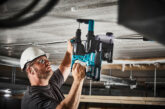
A good quality rod set can save you hours on fiddly cable routing jobs. To get the most from your rods (and its attachments) you need to use them correctly. Super Rod’s Sam Horseman answers some of your FAQs.
Should I be using different colour rods for different jobs?
Yes and no. Our Adoxim rods are colour-coded to tell you how flexible they are (white being the most flexible, black the least) but they aren’t designed to each have a specific purpose. No two installations are the same, so we give you five flexibilities to ensure you have a variety of options to hand.
What difference does the diameter make?
The varying diameters give you more options when choosing your routing solution, e.g. a 6mm black rod gives more stability for longer runs, while a 5mm white nylon rod is great for routing cable through complex situations.
When using multiple rods together for extra length, does it matter what order they go in?
There’s no optimum way of using the flexibilities together, so most installers just adapt the order to the needs of the job. Our most commonly used rod is the red 5mm so this one often goes first!
How can I stop cables from twisting when I’m routing them?
Twisted cables are a no-no, especially for Cat5 and Cat6 cables as it can affect the overall performance of the installation. With one of our swivel rods, installers can pull cable off a drum or out of a box, confident that any cable twist will be dissipated.
How can I stop debris getting into the rod threads?
The domed and flat bullet attachments are both used to prevent dust and debris clogging up the rod threads, which will eventually stop them joining correctly. The flat bullet has also been adapted to clean debris out of the threads.
Best attachments for routing cables in places with a lot of obstructions?
The chain and super magnet are a great attachment combination for this. Together, they give you the ability to route your rods from two different locations, through difficult routes ultimately saving time.
I don’t want to lose my cable in a cavity wall – should I tape it onto the rod?
A pulling sock is a really secure solution, therefore tape is not required. Using it also avoids having to cut the cable loose after pulling it through.
How can you stop a rod from snapping?
The most common causes of damaged rods are over-flexing at the joint past a 90 degree turn. To avoid this, the flexi lead and domed bullet are a great way to get your rod assembly on its way, often providing the start through a challenging angle where a standard rod would be put under excessive pressure.
Any tips for keeping rods in good condition for longer?
Use the bullets to clean your rods and protect your kit by keeping it in the tube packaging provided. Also, don’t lend them to anyone as you might not get them back!
For more information visit: www.super-rod.co.uk









